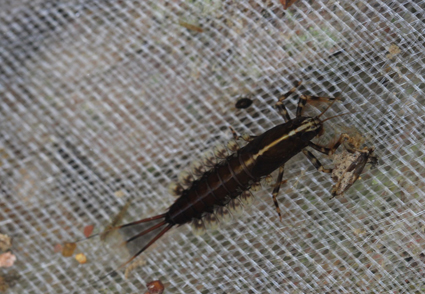Abstract
Isonychia taishunensis Huang, Shen, Zhang & Cheng sp. nov. is described based on larval samples from Taishun County, Zhejiang Province, China. The new species is distinguished from other species of Isonychia Eaton by the following characters: gill plates with spines apically, the color of abdominal tergum X, color pattern of abdominal terga I–IX, and color pattern of each gill plate. The genetic distance between the new species and other species of Isonychia is over 10% using the Kimura 2-parameter model. The phylogenetic relationship of I. taishunensis is close to the clade of I. japonica Ulmer and I. ussurica Bajkova. The morphological characters and molecular data (COX1, Kimura 2-parameter) support that this new species represents the ninth species of the genus Isonychia in China. The modified key to known larvae of the genus Isonychia is provided.
References
- Bae, Y., Lee, J. & Yoon, I. (2000) Northeast Asian Ephemeroptera in Imanishi's 1940 report. Entomological Science, 3, 391–397.
- Bajkova, O.Ya. (1970) New and little-known species of may-flies (Ephemeroptera) from the basin of the Amur River. Entomological Review , 49, 1, 82–87.
- Folmer, O., Black, M., Hoeh, W., Lutz, R. & Vrijenhoek, R. (1994) DNA primers for amplification of mitochondrial cytochrome c oxidase subunit I from diverse metazoan invertebrates. Molecular Marine Biology and Biotechnology, 3, 294–299.
- Guan, J., Zhang, Z., Cao, Y., Xu, X., Storey, K., Yu, D. & Zhang, J. (2021) The complete mitochondrial genome of Choroterpes (Euthralus) yixingensis (Ephemeroptera: Leptophlebiidae) and its mitochondrial protein-coding gene expression under imidacloprid stress. Gene, 800, 145833. https://doi.org/10.1016/j.gene.2021.145833
- Hebert, P., Ratnasingham, S. & De Waard, J. (2003) Barcoding animal life: cytochrome c oxidase subunit 1 divergences among closely related species. Proceedings of the Royal Society of London Series B: Biological Sciences, 270, S96–S99. https://doi.org/10.1098/rsbl.2003.0025
- Hsu, Y. (1936) New Chinese mayflies from Kiangsi Province (Ephemeroptera). Peking Natural History Bulletin, 10, 319–326.
- Imanishi, K. (1940) Mayflies from Manchuria, Lower Mongolia, and Korea. Report of the Limnological Society of Kwantung and Manchoukuo Darien, 169–263. [in Japanese]
- Kang, S. & Yang, C. (1994) The Nymph of lsonychia formosana (Ulmer, 1912)(Ephemeroptera: Oligoneuriidae). Journal of Nature History, 50, 369–375.
- Kimura, M. (1980) A simple method for estimating evolutionary rates of base substitutions through comparative studies of nucleotide sequences. Journal of Molecular Evolution, 16, 111–120. https://doi.org/10.1007/BF01731581
- Luo, Y., Jiang, J., Wang, L., Shu, Z. & Tong, X. (2020) Vietnamella chebalingensis, a new species of the family Vietnamellidae (Ephemeroptera) from China based on morphological and molecular data. Zootaxa, 4868 (2), 208–220. https://doi.org/10.11646/zootaxa.4868.2.2
- Qiang, X. & Zhou, C. (2023) A preliminary review of Isonychia Eaton, 1871 from Chinese mainland with a re-description of I. kiangsinensis Hsu, 1936 (Insecta, Ephemeroptera, Isonychiidae). ZooKeys, 1178, 115. https://doi.org/10.3897/zookeys.1178.104619
- Quan, Y., Bae, Y., Jung, J. & Lee, J. (2002) Ephemeroptera (Insecta) fauna of Northeast China. Insecta Koreana, 19, 241–269.
- She, S. & You, D. (1988) A new species of Isonychia from China (Ephemeroptera: Oligoneuriidae). Pan-Pacific Entomologist, 64, 29–31.
- Tamura, K., Stecher, G. & Kumar, S. (2021) MEGA11: molecular evolutionary genetics analysis version 11. Molecular Biology and Evolution, 38, 3022–3027. https://doi.org/10.1093/molbev/msab120
- Tiunova, T. & Gorovaya, E. (2010) A new species of the genus Isonychia Eaton, 1871 (Ephemeroptera, Isonychiidae) from the Far East of Russia. Euroasian Entomological Journal, 9, 341–344.
- Tiunova, T., Kluge, N. & Ishiwata, S. (2004) Revision of the East Palaearctic genus Isonychia (Ephemeroptera: Isonychiidae). Canadian Entomologist, 136, 1–41. https://doi.org/10.4039/n02-108
- Tong, Y., Shen, C., Zhao, Y., Lin, Y., Wu, L., Storey, K., Yu, D. & Zhang, J. (2022) The genetic diversity and the divergence time in extant primitive mayfly, Siphluriscus chinensis Ulmer, 1920 using the mitochondrial genome. Genes, 13, 1780. https://doi.org/10.3390/genes13101780
- Ulmer, G. (1912) H. Sauter’s Formosa-Ausbeute. Ephemeriden. Entomologische Mitteilungen, 1, 369–375. https://doi.org/10.5962/bhl.part.25902
- Ulmer, G. (1936) Neue chinesische Ephemeropteren, nebst ubersicht uber die bischer aus China bekannten Arten. Peking Natural History Bulletin, 10, 201–215.
- Walker, F. (1853) Ephemerinae. List of the specimens of neuropterous insects in the collection of the British Museum, Part III (Termitidae – Ephemeridae): 533–585.
- Wu, C. (1935) Order VII. Ephemeroptera. In: Wu, C. (Ed.), Catalogus Insectorum Sinensium. Vol. 1. Catalogue of Chinese insects. Fan Memorial Institute of Biology, Peking, pp. 247–253.
- Wu, T., Gui, H. & Shi, Z. (1992) Two new species of genus Isonychia subgenus Isonychia sensu stricto (Ephemeriptera: Isonychiidae). Journal of Nanjing Normal University (Nature Science), 15, 78–83. [in Chinese]
- Xu, X., Guan, J., Zhang, Z., Cao, Y., Cai, Y., Storey, K., Yu, D. & Zhang, J. (2021) Insight into the phylogenetic relationships among three subfamilies within Heptageniidae (Insecta: Ephemeroptera) along with low-temperature selection pressure analyses using mitogenomes. Insects, 12, 656. https://doi.org/10.3390/insects12070656
- You, D. & Su, C. (1987) Descriptions of the nymphs of Choroterpes nanjingensis, Potamanthodes fujianensis and Isonychia kiangsiensis (Ephemeroptera: Leptophlebiidae, Potamanthidae, Siphlonuridae). Acta Zootaxonomica Sinica, 12, 332–336. [in Chinese]
- Yu, D., Yu, P., Zhang, L., Storey, K., Gao, X. & Zhang, J. (2021) Increasing 28 mitogenomes of Ephemeroptera, Odonata and Plecoptera support the Chiastomyaria hypothesis with three different outgroup combinations. PeerJ, 9, e11402. https://doi.org/10.7717/peerj.11402
- Zhang, J., Zhou, C., Gai, Y., Song, D. & Zhou, K. (2008) The complete mitochondrial genome of Parafronurus youi (Insecta: Ephemeroptera) and phylogenetic position of the Ephemeroptera. Gene, 424, 18–24. https://doi.org/10.1016/j.gene.2008.07.037


